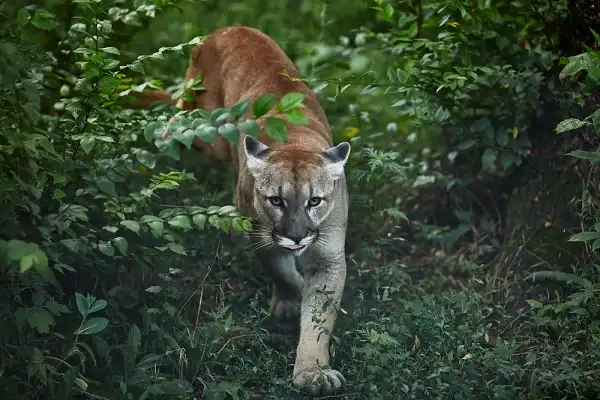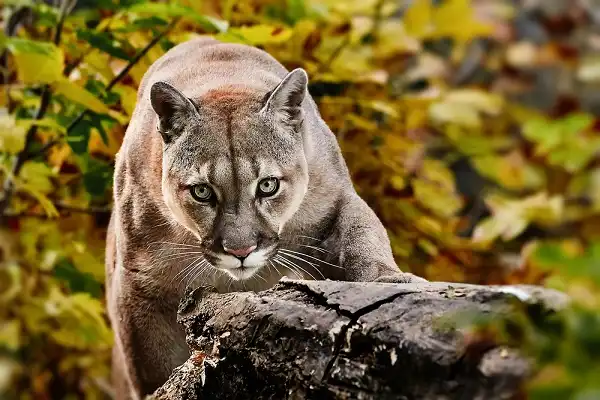If you are a wildlife enthusiast, then the puma is a must-see animal for you. Known by many names like mountain lion, cougars, or panther cats; these majestic creatures captivate us as soon as they come into view with their powerful predator activity and beautiful features. Get to know Pumas up close and personal – learn about their behavior, how they survive in the wild, and what measures can be taken to help save this endangered species from extinction. Read on to find out more about one of nature’s most spectacular marvels – the incredible puma!

Puma Description
The puma (Puma concolor) is an awe-inspiring creature with a muscular, long-bodied structure and powerful, long legs. Its fur coat can range from light yellowish brown to blackish gray. It has a broad head with round ears that point slightly upward, and its eyes are usually shades of green or yellow. The puma also sports a short mane around the neck area and shoulders which gives it a unique look compared to other cats. While hunting, the puma is known for its stealthy movement as well as agility due to its slender frame and muscular back legs which enable it to make powerful leaps of up to 10 meters in distance. In addition, some individuals have been observed using their front paws as tools or weapons when hunting or defending themselves from predators.
Puma Habitat
The puma is native to many regions of the Americas, including North, Central, and South America. Its range stretches from Canada down to the southern tip of South America, covering all types of ecosystems including deserts, mountains, forests, jungles, and even grasslands. Pumas are very adaptable animals, able to survive in both humid and dry climates as well as high altitudes up to 3,500 meters! Pumas are most commonly seen in areas where it’s easy for them to hunt their prey – like open meadows or wooded areas. They also prefer habitats with plenty of rocky outcrops that provide shelter and places for them to hide. In addition, they need access to water sources such as rivers or streams for drinking and bathing purposes. Pumas occupy large home ranges that can cover up to 400 square kilometers depending on the availability of food and other resources. As a result, they are considered one of the least territorial cats in the world since their ranges often overlap with each other’s instead of being exclusive territories. Moreover, female pumas will usually stay in one area whereas males tend to wander more widely across larger distances looking for mates or food resources.
Puma Diet
The diet of the puma consists mainly of small to medium-sized mammals such as deer, rabbits, and rodents. Pumas are also known to eat birds and reptiles when available. They are ambush predators that can hunt effectively through their powerful senses of hearing, sight, and smell. Furthermore, they have incredibly strong bodies with impressive agility and muscular back legs which enable them to make long leaps up to 10 meters in distance. Pumas usually hunt alone and they use a variety of techniques including stalking, chasing, and ambush. It’s not uncommon for them to wait in hiding until their prey is close enough before pouncing on it with great power and speed. When hunting larger animals like deer or elk they typically go for the throat or head area to ensure a quick kill.
Puma Size
Pumas are large cats that can reach up to 8 feet in length and weigh anywhere from 75-220 pounds. Their coat is usually a tawny brown with some light flecks on the neck, underbelly, and legs. They have long and slender bodies, deep chests, short legs, and powerful jaws which make them excellent hunters. Pumas tend to be larger in North America than they are in South America due to differences in climate and food sources. Male pumas are generally larger than females, but female pumas can still reach impressive sizes of up to 2 long! Pumas also vary greatly in size depending on their geographical location as those living in colder climates tend to be bigger overall than those living in warmer environments.

Puma Lifespan
Pumas have an average lifespan of 12 to 15 years in the wild, though some individuals may live up to 20 years. In captivity, pumas can live up to 25 years or more. The majority of mortality is due to hunting by humans or competition with other animals such as wolves and bears. Females tend to have a slightly longer lifespan than males due to their smaller size and lighter hunting load. Pumas reach sexual maturity around 2–3 years of age, but they do not become fully independent until about 4–5 years old when they start hunting on their own. They form pair bonds that can last for life, although these bonds are often broken due to the death or dispersal of one partner. Pumas have been known to travel long distances, sometimes up to 200 miles during their lifetime in search of food or mates. This behavior is highly dependent upon prey availability and male-female ratios in the area. It also helps ensure that the species survives as a whole by increasing the dispersal of genes and avoiding inbreeding depression.
Puma Behavior
Pumas are solitary animals that spend most of their time alone, though they may form pair bonds for life when mating or raising cubs. They hunt mainly at night and will often investigate a potential meal before attempting to catch it. Pumas will stalk their prey for long distances before leaping on it from behind and using their powerful jaws to take down their meal. In terms of communication, pumas tend to be quite vocal with one another, using a variety of sounds like growls, purrs, and barks to express themselves. They also communicate through scent marking by leaving urine or scat around their territories which helps them stay informed about other cats in the area. Pumas are also very territorial and will defend their territory fiercely if needed! When it comes to social behavior, pumas typically keep to themselves but have been known to interact peacefully with one another if they spot each other from a distance. They may even play together or share food if they get close enough! However, this kind of behavior is rare and usually only seen between related individuals such as siblings or mother-daughter pairs.
Puma Speed
Puma speed is an impressive feat, as these predators can reach speeds of up to 50 miles per hour over short distances. This makes them one of the fastest animals in the world and helps explain why they’re so successful at hunting their prey. They couple this speed with incredible strength and agility, enabling them to outmaneuver other predators like wolves and bears that may try to take away their kill. It also gives them the ability to travel long distances when searching for food or mates, sometimes up to 200 miles in a lifetime. The body of a puma is built for speed—it’s slender and muscular with powerful hind legs that are adapted for explosive sprinting movements. Its feet are equipped with sharp claws which provide traction on various surfaces while running. The fur on its coat is silky smooth, allowing air to flow freely around its body which reduces drag and increases speed. Additionally, its tail acts like a rudder when it’s running which helps it steer and maneuver quickly and accurately.

Puma Hunting
Puma hunting is an essential part of their survival in the wild. Pumas are skilled predators that use a combination of stealth, speed, and agility to take down their prey. They will stalk their prey for long distances before pouncing on them from behind, using their strong jaws to finish the job. Pumas can take down large animals such as deer or wild boar despite being relatively small in comparison. Pumas hunt mainly at night, relying on their sharp senses and keen eyesight to find potential meals. They have an acute sense of hearing which helps them detect prey even in darkness, while their strong sense of smell allows them to track prey over long distances. Additionally, they use scent marking as a form of communication with other cats in the area which helps them stay informed about other predators in the area. When it comes to hunting techniques, pumas rely heavily on ambush tactics and stealthy movements to outmaneuver and catch their prey without being noticed by other animals or humans. They will often wait patiently for hours until the perfect opportunity arises before striking with great speed and accuracy! Additionally, they have a powerful bite force that enables them to crush bones and break large animal skulls if necessary.
Puma Rehabilitation
Puma rehabilitation is an important part of conservation efforts for this species. Due to habitat destruction, poaching, and other threats, pumas have become increasingly rare in certain areas. As a result, there are now many organizations and programs dedicated to rehabilitating injured or displaced puma populations. Rehabilitation efforts focus on providing a safe environment for pumas to heal and learn the necessary skills to survive in the wild. In order to do this, specialized care centers provide medical attention and nutrition for injured animals as well as physical therapy when needed. Additionally, trained professionals work with pumas to teach them essential hunting skills such as stalking prey and using ambush tactics which are crucial for survival in the wild.
Rehabilitated pumas are also given tracking devices so that their movements can be monitored once they’re released back into the wild. This helps researchers understand how these animals interact with their environment so that they can provide better protection for them moving forward. The success of puma rehabilitation depends on a number of factors such as access to suitable habitats where they will be safe from human interference, adequate food sources, and suitable mates to breed with. It also requires ongoing support from both local communities and government agencies in order to ensure that these endangered animals continue to thrive in the future!
Puma Predators
Due to their size and strength, pumas are not usually preyed upon by other animals. However, when threatened, they must protect themselves from potential predators such as bears, wolves, and even other cats. While pumas have a variety of strategies that help them avoid being attacked, the most effective is their incredible speed which allows them to outrun any potential threats. While these tactics can be successful at deterring some predators, there are still those that pose a threat to pumas such as cougars and jaguars who share similar habitats with them. These larger cats have the strength and agility necessary to successfully hunt down adult pumas as well as vulnerable cubs when they become separated from their mothers. Furthermore, packs of large predatory animals such as wolves have been known to hunt down entire families of puma if given the opportunity.

Conclusion
Pumas are incredible predators that use their speed, agility, and strength to survive in the wild. Their impressive speed allows them to outrun other animals and cover long distances when looking for food or a mate. Additionally, they have an acute sense of hearing and smell which helps them detect prey even in darkness. Puma hunting is essential for survival as these predators rely on stealthy movements and ambush tactics to take down their meals. With proper protection from habitat destruction and hunting regulations, these animals can continue to thrive in the wild!
Frequently Asked Question

